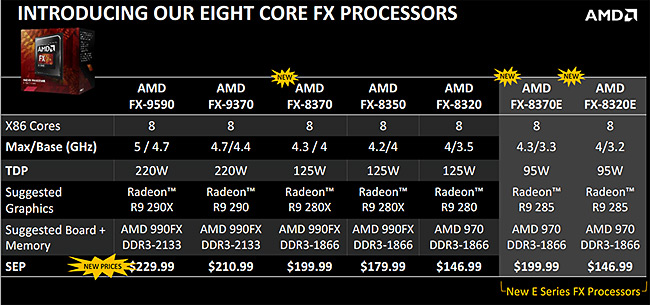It is tempting to simply count the number of processor cores and focus on clock speeds but sooner or later we have to look at power draw for which we can use TDP as a proxy, and this is where AMD has suffered.
To take two examples, Intel Core i7-3770K has a base speed of 3.5GHz and Turbos up to 3.9GHz while the AMD FX-8320 starts at 3.5GHz and runs up to 4GHz. On paper the two processors are near-identical and as the FX costs £100 while the Core i7 is £230 you might think it is game, set and match to AMD. In fact the Intel is a better performer and manages with a TDP of 77W, whereas the FX has a TDP of 125W – so the question about which family of CPU you should buy remains complicated.
AMD has been forced to put the emphasis on clock speed to close the performance gap with Intel and the result was clear at the launch of its FX-9xxx chips that clock up to 5GHz turbo speed. That is impressive but unfortunately FX-9590 and FX-9370 require a 220W TDP to achieve this feat which inevitably means you will have to deal with loads of heat and a significant cooling solution to keep things under control.
AMD updated its FX-x1xx Bulldozer models with Piledriver cores, denoted by a change in model codes to FX-x3xx, however that was more a matter of refinement rather than reinvention. When AMD brought out its third generation Steamroller cores they were restricted to the Kaveri family of APUs and were explicitly not extended to FX.
This refusal to use Steamroller pretty much felt like the end of the line for the FX desktop processor. Without development it could only get less appealing compared to Core i7, so in many respects AMD has pulled a rabbit from the hat with its latest announcements as it has reinvented its product stack pretty much out of thin air.
If you prefer, you can think of it as a placeholder while AMD develops its Zen microarchitecture.
At the high end the FX-9590 and FX-9370 have had their prices cut. Below that we see the introduction of FX-8370 which is 100MHz faster than the FX-8350, presumably thanks to improvements in the fabrication process.
The existing FX-8350 and FX-8320 models remain in place and then we see the introduction of FX-8370E and FX-8320E which are 95W versions of the non-E 125W CPUs.
AMD gives no clue as to how it has achieved this trick, despite the fact that lopping 30W off the TDP is a massive step. Judging by the specifications, the FX-8370E appears to be identical to the FX-8370 – except for a lower base speed of 3.3GHz compared to 4.0GHz for the 125W model. The Turbo speed of 4.3GHz is the same for both models, so the reduction in TDP is little short of amazing and well worth investigating.
 KitGuru KitGuru.net – Tech News | Hardware News | Hardware Reviews | IOS | Mobile | Gaming | Graphics Cards
KitGuru KitGuru.net – Tech News | Hardware News | Hardware Reviews | IOS | Mobile | Gaming | Graphics Cards



